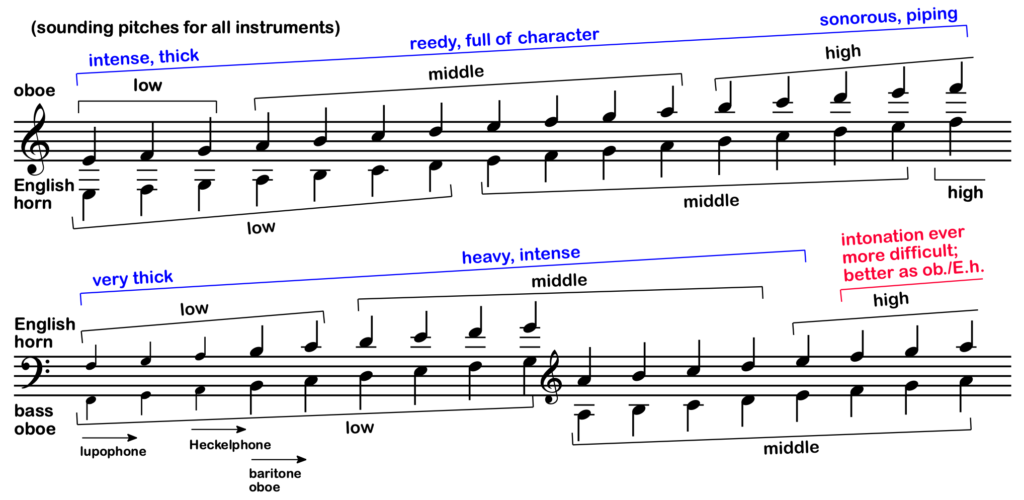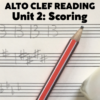(Tip no. 4 from 100 MORE Orchestration Tips, to be released in March 2020)
Exposed woodwind octaves using members of the same families of instruments can be very effective, so long as the registers are balanced in dynamics and timbre.
In my lecture at Azusa University earlier this year, I shared a tip regarding exposed woodwind octaves between different instrument families (which will be available as a more organised chapter in 100 MORE Orchestration Tips). But what about octaves within the same families of instrument? Just as much as before, the key to finding ideal timbral and dynamic balance lies with registers. Whether you’re combining the same two instruments in octaves, or a standard instrument and its auxiliary, the same principle applies. Let’s examine each concert wind family for its strongest octave combinations.
Generally speaking, you can combine any two standard wind instruments of the same type in exposed octaves, so long as the upper and lower notes are fairly equal in dynamic strength, and compatible in quality of timbre. You just have to accept that the resonance of the combined tones will be somewhat organ-like at best. Of course, the context of the surrounding texture of any passage may lessen or strengthen that impression, so the similarity is really yours to work with or against as an orchestrator. In the case of two flutes, octaves from A4/5 and up tend to be very usable, with the lower pitch beautifully reinforcing the upper pitch similar to first and second violins in octaves. Even the overpowering altissimo high range can be balanced from below as long as the dynamic is forte and above in both parts. Not so effective are combinations of the lowest register of the flute in octaves with itself. The softer, breathy timbre of the low range doesn’t combine as seamlessly as the rounder, more radiant middle register – at least at higher volumes. But the upper player can moderate their approach to be breathier to match the lower player in gentler passages.

Fig. 04a: Octave combinations across the range of the standard C flute. This chart could also apply to the combination of two piccolos in octaves – and accepting some unique considerations of range and timbre, to combinations of two alto flutes or two bass flutes. Ditto for the other charts below applying to either two of the main instrument of a family or to two auxiliaries.
Everything I said above about combining two standard flutes in octaves could apply to any two flute family auxiliaries of the same type; two piccolos, or even two alto or two bass flutes if one scored to match their individual registers to one another. But the best way to score timbrally and dynamically balanced woodwind octaves within families is to score a standard instrument doubled by an auxiliary. That way the unique qualities of each instrument’s registers will be replicated above and below. A piccolo and standard flute playing octaves will both sound breathy and liquid in their lower registers, lucid and warm in their middle registers, and clear and ringing in their upper and altissimo registers. The same could be said for an alto or bass flute tracking a standard flute from below, especially useful if the passage stays in the lower and middle registers of both instruments. This combination taken up to the highest available notes will probably lose balance as the lower flutes start to lose radiance and become ever cooler in tone.

Combined oboes probably have the smallest range of ideally balanced octaves: the span of around a ninth, from around E4/5 to E5/6. This combination is rare, because it has a powerfully reedy sound, that some might call “rustic.” Lower than this middle range, the bottom notes become a bit too potent, and may overwhelm the resonance of the higher notes. Above E5/6, the upper notes tend to become quite thin compared to the richer lower notes.

The natural octave-down range of the bass oboe might seem to suggest that it would be the ideal partner for standard oboe in octaves. I feel this doesn’t automatically follow, however. Bass oboe family members have a solidity and richness to their range that easily might overplay their little sister (the possible exception being a lupophone, which would still require finesse to balance). As I’ve written in Tip 15 from 100 Orchestration Tips, the English horn may be a better partner in octaves for the oboe, from concert E3/4 all the way up to F6/5 – adding a full octave of range to what’s possible between two oboes. For an octave partner above the bass oboe, I’d prefer English horn. If the bass oboe model is a lupophone, the possibilities of matching timbre and dynamics covers over two octaves of range. Keep in mind that this combination will be intensely reedy, far more than the case with oboe octaves.

Clarinet octaves are probably more common than oboe octaves in the literature – appearing in works by Romantic colourists like Tchaikovsky and Mahler. And yet I would urge even more caution in scoring the combination, because the reinforcing of overtones results in an extremely penetrating timbre with a somewhat coarse quality. All the same, octaves sound balanced throughout the range of the instrument, not affected by timbral differences in registers.

For all the balance that two standard clarinets may be able to achieve, if the orchestrator is looking for an extremely fine balance of precise register characteristics and dynamics, then they should score octaves between B-flat clarinet and bass clarinet. Every register is identical throughout, just as is the case between piccolo and standard flute. If the octave needs to sit harshly on the throat tones, then we’ll hear that shallow blaring both above and below. Most importantly, the chalumeau register is completely opened up for the upper clarinet all the way down to its lowest note. As for contrabass clarinet/bass clarinet combinations, these are plentiful in 1950’s/60’s film and television scoring, and can effectively cover at least two octaves of range before becoming superfluous.

One might well ask about the efficacy of combining E-flat clarinet in octaves above standard clarinet; and this does happen from time to time in the literature, with about the same piercing sound as two standard clarinets playing octaves. It would be intriguing to hear the E-flat playing octaves with its octave version, the E-flat alto clarinet. The strange veiled quality of the alto might combine in uniquely colourful ways with the shallower E-flat sopranino.
Which just leaves the bassoon family. Bassoons play octaves frequently, with an effective range of about an octave-and-a-half. The wonderfully dark sound of bassoon octaves has made its way into countless scores, particularly in Russian orchestration. It is just as potent as oboe octaves. However, as the low notes rise into the tenor register and the high notes into the high register, this magic quickly leaches away and the combination becomes ever more treacherous for the players and suspenseful for the listener.

Contrabassoon/bassoon octaves are standard in scoring, and can sound superbly ominous in the forefront of a texture. The lowest two octaves of range are perfectly dependable, above which the quality of combined tone generally depends on the quality of the performers. There will rarely be any reason to go higher than Bb2/3; but if one must, then I’d push it no higher than F3/4 at the very highest.

Remember once again that all the advice and charts above refer to the specific instance of exposed octaves, and not all cases in which these instruments form textural relationships in octaves. All the same, just because a combination is somewhat out of balance doesn’t mean that it’s completely unusable. The orchestrator just needs to be aware of how much out of balance they may be pushing the arrangement, and whether it’s fair to the burden on the conductor and the players to fix the problem. If the result is ingenious, then your performers may work hard to fulfil your intentions. If not, you may just be wasting everyone’s time, and your own during rehearsal.









